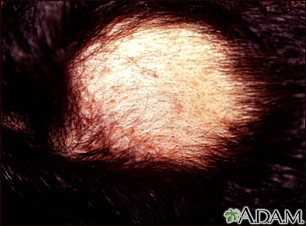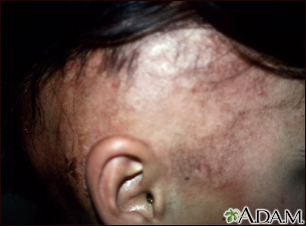Bill’s blessing in disguise: ‘Cancer saved my life’
William Blue did not wish for cancer but is now thankful he had it. Bill’s diagnosis, at age 56, was his reckoning – a life-changing experience that may have…

Update your location to show providers, locations, and services closest to you.
Partial or complete loss of hair is called alopecia.
Loss of hair; Alopecia; Baldness; Scarring alopecia; Non-scarring alopecia
Hair loss usually develops gradually. It may be patchy or all over (diffuse). Normally, you lose roughly 100 hairs from your head every day. The scalp contains about 100,000 hairs.
HEREDITY
Both men and women tend to lose hair thickness and amount as they age. This type of baldness is not usually caused by a disease. It is related to aging, heredity, and changes in the hormone testosterone. Inherited, or pattern baldness, affects many more men than women. Male pattern baldness can occur at any time after puberty. About 80% of men show signs of male pattern baldness by age 70 years.
PHYSICAL OR EMOTIONAL STRESS
Physical or emotional stress may cause one half to three quarters of scalp hair to shed. This kind of hair loss is called telogen effluvium. Hair tends to come out in handfuls when you shampoo, comb, or run your hands through your hair. You may not notice this for weeks to months after the episode of stress. Hair shedding decreases over 6 to 8 months. Telogen effluvium is usually temporary. But it can become long-term (chronic).
Causes of this type of hair loss are:
Some women ages 30 to 60 years may notice a thinning of the hair that affects the entire scalp. The hair loss may be heavier at first, and then gradually slow or stop. There is no known cause for this type of telogen effluvium.
OTHER CAUSES
Other causes of hair loss, especially if it is in an unusual pattern, include:
Hair loss from menopause or childbirth often goes away after 6 months to 2 years.
For hair loss due to illness (such as fever), radiation therapy, medicine use, or other causes, no treatment is needed. Hair usually grows back when the illness ends or the therapy is finished. You may want to wear a wig, hat, or other covering until the hair grows back.
Hair weaves, hair pieces, or changes of hair style may disguise hair loss. This is generally the least expensive and safest approach to hair loss. Hair pieces should not be sutured (sewn) to the scalp because of the risk for scars and infection.
Call your health care provider if you have any of the following:
A careful medical history and examination of the hair and scalp are usually enough to diagnose the cause of your hair loss.
Your provider will ask detailed questions about:
Tests that may be performed (but are rarely needed) include:
If you have ringworm on the scalp, you may be prescribed an antifungal shampoo and oral medicine for you to take. Applying creams and lotions may not get into the hair follicles to kill the fungus.
Your provider may advise you to use a solution, such as Minoxidil that is applied to the scalp to stimulate hair growth. Other medicines, such as hormones, may be prescribed to decrease hair loss and promote hair growth. Drugs such as finasteride and dutasteride can be taken by men to decrease hair loss and grow new hair.
If you have a certain vitamin deficiency, your provider will likely recommend that you take a supplement.
Hair transplant may also be recommended.








Phillips TG, Slomiany WP, Allison R. Hair loss: common causes and treatment. Am Fam Physician. 2017;96(6):371-378. PMID: 28925637 pubmed.ncbi.nlm.nih.gov/28925637/.
Sperling LC, Sinclair RD, El Shabrawi-Caelen L. Alopecias. In: Bolognia JL, Schaffer JV, Cerroni L, eds. Dermatology. 4th ed. Philadelphia, PA: Elsevier; 2018:chap 69.
Tosti A. Diseases of hair and nails. In: Goldman L, Schafer AI, eds. Goldman-Cecil Medicine. 26th ed. Philadelphia, PA: Elsevier; 2020:chap 413.



William Blue did not wish for cancer but is now thankful he had it. Bill’s diagnosis, at age 56, was his reckoning – a life-changing experience that may have…

Hair loss. It’s one of the signatures of aging, especially for men. And for some of us, those hair follicles frolic right out of our lives even while we’re still relatively young. But does hair...
Male pattern baldness is commonly expected, but women experience hair loss, too. About 40 percent of those adults losing their hair are women, according to the American Hair Loss Association. The...